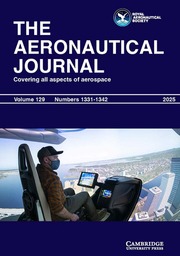Article contents
On the effect of a strake-like junctionfillet on the lift and drag of awing
Published online by Cambridge University Press: 04 July 2016
Summary
An experimental study of the effects on the low-speedaerodynamic characteristics of a strake-like filletis described, modelled on one used on an Airbus A320variant fitted at the leading edge of a sweptwing-plate junction. The wing, swept back at 20°,was of NACA 0015 section and chord 500 mm, bothnormal to its leading edge. A turbulent boundarylayer had developed on the plate well ahead of thejunction. The tests were conducted at a unitReynolds number of 1.56 x 106m-1.
Surface pressure distributions were measured on theplate in the neighbourhood of the leading edgejunction and also on the aerofoil and fillet at wingincidences of 0°, 3°, 6°, 9° and 12°. These weresupplemented by surface oil-flow studies.
The mean velocity and turbulence intensity fieldsaround the leading edge were examined for incidencesof 0° and 9°, using both a single tube yaw meterdeveloped for the purpose and an X-wire anemometer.The X-wire anemometer was also used downstream ofthe trailing edge of the swept wing; five of theReynolds stresses and the mean velocity field weremeasured.
The sectional lift coefficients on the aerofoil werefound to diminish as the junction was approached,slightly more so with the fillet than without it.The sectional drag coefficients due to pressureincreased as the junction was approached, the filletmoderating this increase to only a small extent.
However, the addition of the drooped fillet modifiedthe flow considerably. The horseshoe-like vortex wasless well defined than without it. At zeroincidence, the peak in the turbulence intensitylevels was virtually eliminated on what becameeffectively the compression side of the wing due tothe local camber introduced by the asymmetricfillet. The turbulence levels were also reduced bythe addition of the fillet at an incidence of 9°.However, the turbulent activity was spread through alarger proportion of the viscous region. Thesecondary flows and the turbulence activity in thewake are associated with unrecoverable kineticenergy and will be manifest as drag on the surfacesforming the junction.
It is concluded that a carefully designed fillet,optimised for the cruise incidence of an aircraft,can reduce the peak turbulence levels in thejunction. It remains unclear whether the total dragassociated with the junction flow can be reducedsignificantly.
However because of its effects on the turbulence, theremay be other benefits, for example on the efficiencyof downstream elements, such as fuselage-mountedengine intakes or the following stages of an axialflow machine. Junction fillets might also be used tocontrol the scouring of river beds around bridgepiers.
Information
- Type
- Research Article
- Information
- Copyright
- Copyright © Royal Aeronautical Society 1996
Footnotes
Currently at DERA, Farnborough, UK
References
- 4
- Cited by

